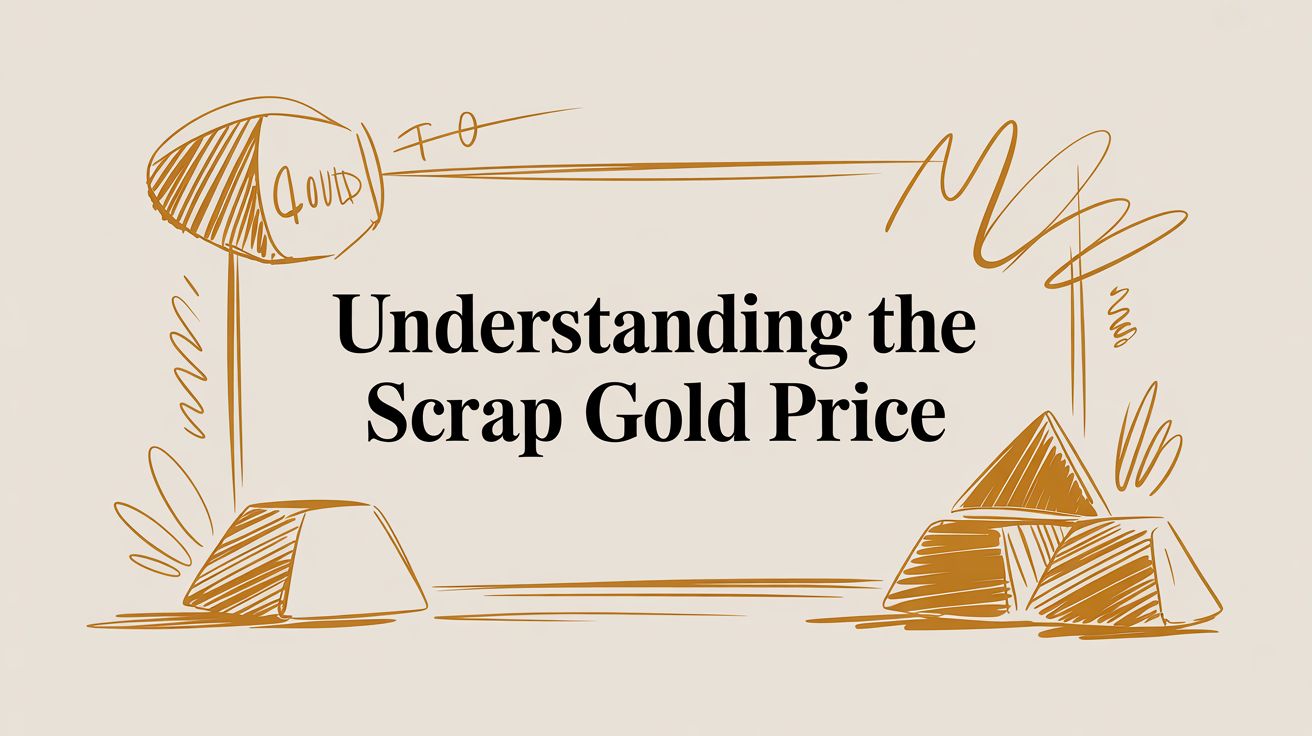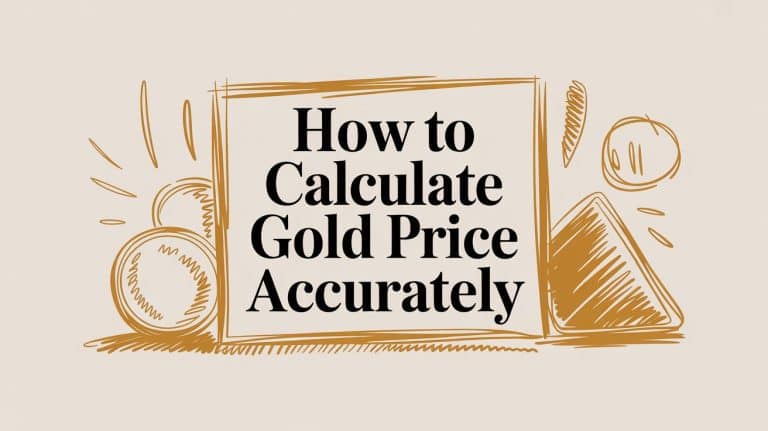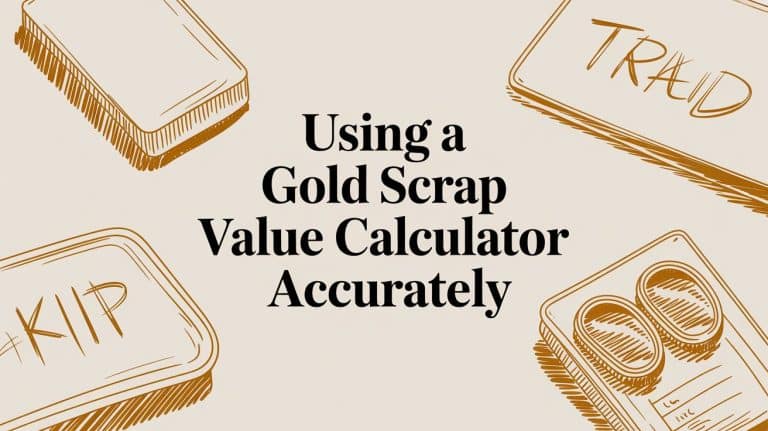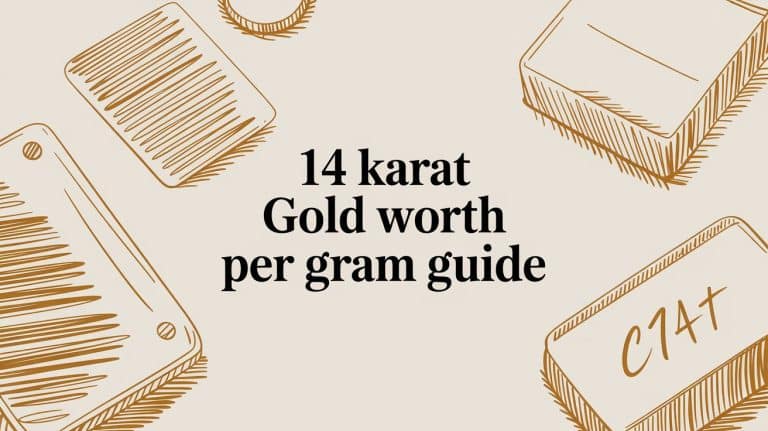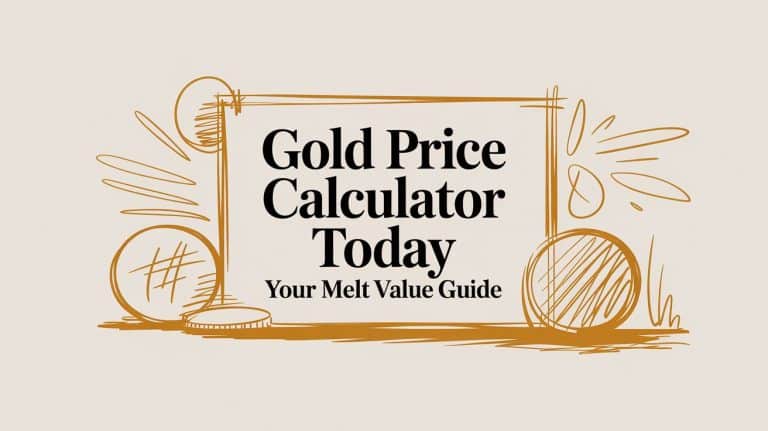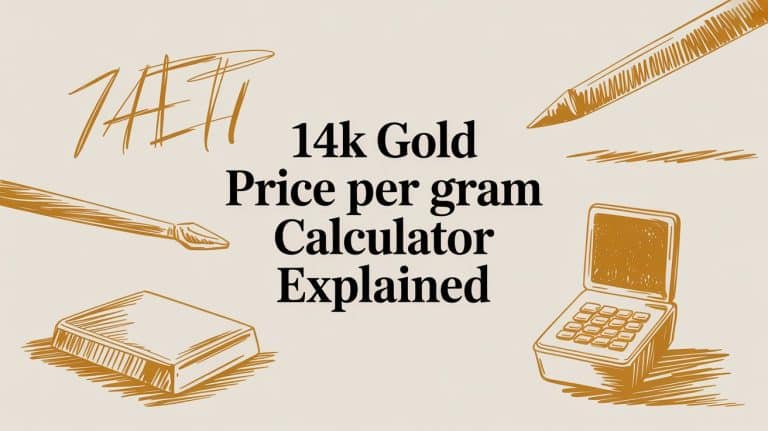Understanding the Scrap Gold Price in 2026
Ever wonder what that old, broken, or mismatched gold jewelry hiding in your drawer is actually worth? The secret lies in understanding the scrap gold price. This is not about what you paid for it at the store or its sentimental value; it is the raw value of the pure gold inside.
This guide will pull back the curtain on how that price is calculated, giving you the insider knowledge to sell with confidence.
The Hidden Value in Your Unwanted Gold
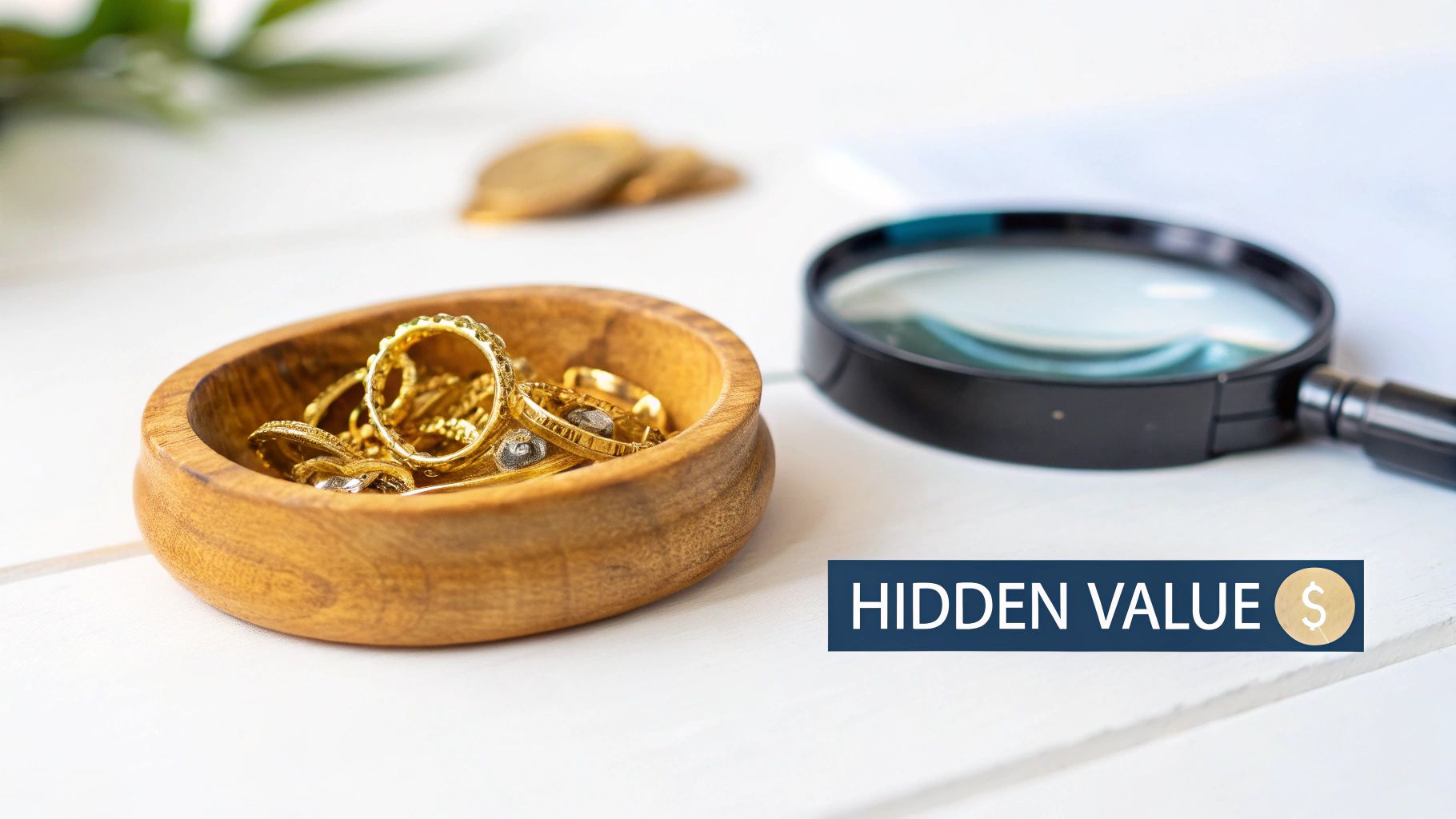
So many of us have a tangled chain, a single earring, or an outdated ring tucked away somewhere. They might not be wearable anymore, but do not mistake them for junk. These pieces hold real, tangible value because of the gold they contain, gold that can be melted down, refined, and given a new life.
The scrap gold price is simply the market value of this raw material. Think of it this way: once a ring is destined for the melting pot, its beautiful design no longer matters. The focus shifts entirely to three core factors that determine its true cash value.
Core Elements of Scrap Gold Value
To figure out what you can realistically expect when you sell, you need to know what buyers are looking for. It all boils down to a simple, transparent formula based on three key things.
- The Live Market Price: This is the “spot price” of gold, which is constantly changing based on global trading. We will explain this in more detail shortly.
- The Item’s Weight: Accuracy is everything. Buyers use finely calibrated scales to weigh items, usually in grams.
- The Karat Purity: This tells you the percentage of pure gold in your item versus the other metals, known as alloys, mixed in for strength.
Our goal is to arm you with the knowledge to walk into any negotiation and know you are getting a fair shake. By breaking down these concepts, you will see your gold’s true potential.
Market Dynamics and Timing Your Sale
The price of gold is not set in stone. It moves up and down daily based on global economic news, which makes when you sell just as important as what you sell.
The scrap gold price is directly tied to the market spot price, which has seen some wild swings and record highs in recent years. For instance, in October 2025, the gold price rocketed to an all time high of $4,381.58 per troy ounce. That was a staggering 48.42% increase from the same time the previous year. This huge jump was driven by things like inflation fears, global tensions, and shaky currency values. You can dive deeper into these gold market trends over at TradingEconomics.com.
Keeping an eye on these market trends can make a huge difference. Selling when prices are peaking can seriously boost your payout, turning that forgotten jewelry into a smart financial move.
The Three Core Factors of Gold Valuation
Figuring out the price of your scrap gold is not some mysterious art. Every professional buyer, from the local pawn shop to the largest refiner, uses the exact same three part formula to determine what your items are worth. Think of it like a simple recipe with three essential ingredients.
Get these right, and you will know exactly what your gold is worth before you even walk in the door. The core factors are the live Spot Price, the gold’s Purity (its karat), and its Weight. Each one is a crucial piece of the puzzle, and understanding how they work together is the key to getting a fair and transparent price.
Understanding the Spot Price
First up is the spot price. This is the live, up to the minute market price for one troy ounce of pure, 24 karat gold. It is like the stock market ticker for gold, constantly moving up and down as traders buy and sell on global exchanges. Every single gold valuation starts with this baseline number.
The spot price does not move randomly; it reacts to major world events. Historically, scrap gold prices have been tied to big picture economic news like inflation reports, currency fluctuations, and geopolitical stability. For example, in late October 2024, the market went wild after the US released some key Consumer Price Index (CPI) data. On October 21, 2024, the gold price plummeted 5.39%, which was about $235 per ounce, the biggest single day percentage drop in over a decade. You can find more historical price data over at USA Gold.
Gold Purity: The Karat System
Next, we need to know the purity of your gold. How much actual gold is in that chain or ring? Since pure gold (24K) is incredibly soft, it is almost always mixed with other metals like copper, silver, or zinc to make it strong enough for jewelry. This blend of metals is called an alloy, and its gold content is measured in karats (K).
A piece marked 24K is 99.9% pure gold. An 18K piece, on the other hand, is 75% pure gold, that is simply 18 divided by 24. The lower the karat, the less pure gold it contains. Most jewelry has a tiny stamp, or hallmark, indicating its karat, like “14K” or “18K.” You might also see European style fineness numbers, like “585” on 14K gold, which just means 58.5% pure. For a deeper dive into finding these marks, check out our guide on how to test gold purity.
Understanding your item’s karat is non negotiable. A 10 gram chain marked “18K” contains twice as much pure gold as a 10 gram chain marked “9K,” which dramatically impacts its value.
To make this crystal clear, here is a simple table breaking down the most common gold karats.
Common Gold Karats and Pure Gold Content
This table shows the relationship between the karat stamp you will see on jewelry, its corresponding fineness number, and the actual percentage of pure gold it contains.
| Karat (K) | Fineness Hallmark | Pure Gold Percentage | Common Use |
|---|---|---|---|
| 24 Karat | 999 | 99.9% | Investment bars, coins |
| 22 Karat | 916 | 91.6% | High end jewelry, coins |
| 18 Karat | 750 | 75.0% | Fine jewelry, watches |
| 14 Karat | 585 | 58.5% | Standard for U.S. jewelry |
| 10 Karat | 417 | 41.7% | Durable, affordable jewelry |
| 9 Karat | 375 | 37.5% | Common in the U.K. |
Having this chart handy is a great way to quickly translate any hallmark you find into a real number you can use for your calculations.
The Importance of Accurate Weight
The final piece of the puzzle is weight. It is simple: the heavier the item, the more gold it contains, and the more it is worth. Professionals use highly precise, certified scales that measure in grams, but you might also hear terms like pennyweights (dwt) or troy ounces.
It is crucial to know how these units relate to each other:
- 1 troy ounce = 31.1 grams
- 1 pennyweight (dwt) = 1.555 grams
- 20 pennyweights (dwt) = 1 troy ounce
Do not underestimate the need for precision here. A small miscalculation in weight can change the final scrap gold price significantly. Once you combine an accurate weight with the correct purity and the current spot price, you have everything you need to find the true melt value of your gold.
How to Calculate Your Gold’s Melt Value
Alright, now that you have the key concepts down, let’s put them into practice. Calculating your gold’s melt value, what the actual gold in your item is worth, is much simpler than you might think. It is the same basic math that professionals use, and knowing it gives you a powerful starting point before you even talk to a buyer.
This is not about guesswork. It is about turning abstract ideas like purity and weight into a real dollar figure, giving you a solid baseline for any sale.
The Simple Formula for Melt Value
At its core, the calculation is just a three step multiplication. You are combining the three pillars we have already covered: your item’s weight, its purity, and the current market price for gold.
Here is the formula the pros use:
(Item’s Weight in Grams) x (Gold Purity Percentage) x (Current Spot Price per Gram) = Melt Value
This calculation cuts straight to the chase, stripping away any sentimental value or retail markup. It tells you the raw, intrinsic worth of the gold itself. This is the number that every scrap gold price is based on. If you want to dive deeper into the details, check out our guide on how to calculate gold price.
This infographic breaks down the process visually, showing how you get from an old piece of jewelry to a real time valuation.
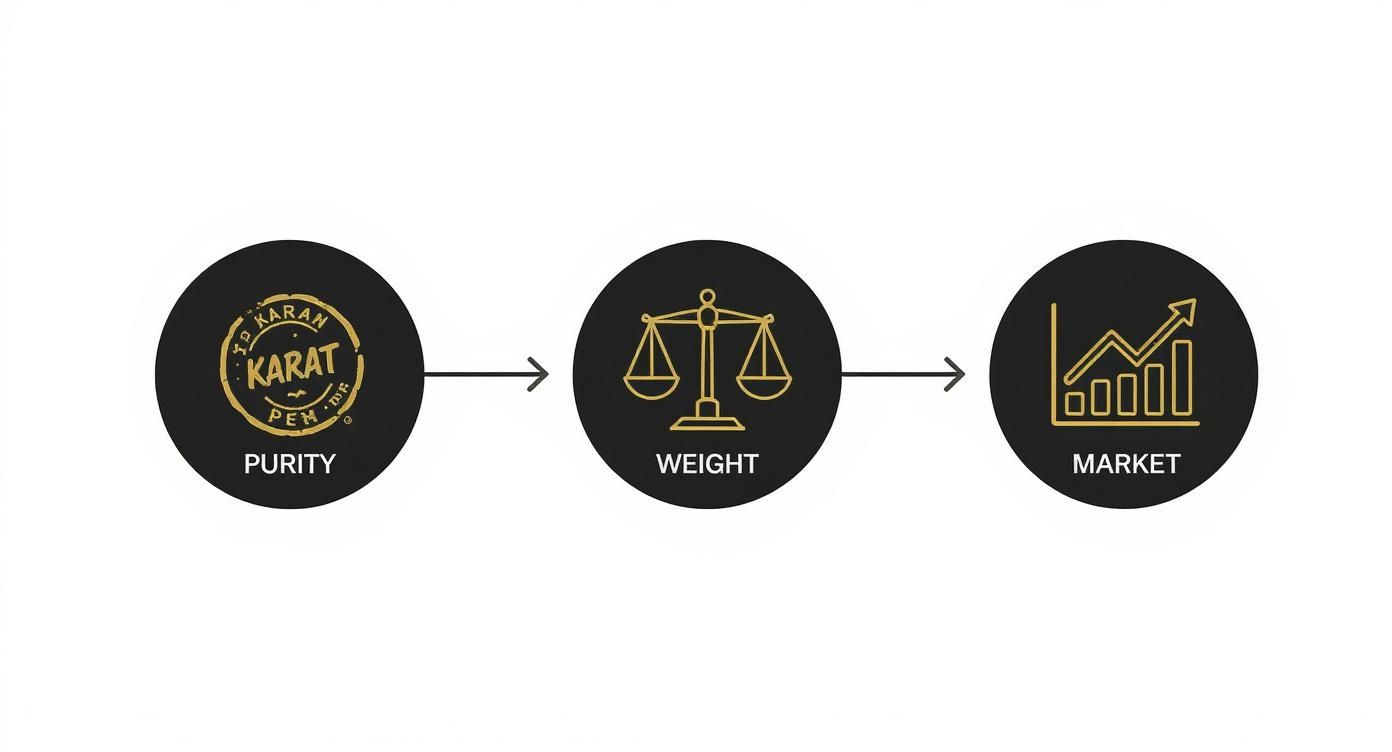
As you can see, each step logically follows the last, leading you straight to an accurate melt value based on solid data.
A Real World Example
Let’s make this crystal clear. Imagine you have a 14K gold chain you are thinking of selling. You pop it on a digital kitchen scale, and it weighs in at 10 grams. So, what is it worth?
First, you need the live spot price of gold. For this example, let’s say the current price is $75 per gram for pure, 24K gold.
Next, you need the purity of 14K gold. As we learned, 14K is 58.5% pure gold.
Now, we just plug those numbers into our formula:
- Weight: 10 grams
- Purity: 0.585 (which is 58.5%)
- Spot Price: $75 per gram
The math looks like this: 10 grams x 0.585 x $75 = $438.75.
Just like that, you know the melt value of your 10 gram, 14K gold chain is $438.75. This is the full, fair market value of the pure gold in your item before any buyer takes their cut.
Unit Conversion the Easy Way
You will often see the spot price quoted per troy ounce instead of per gram. Do not let that throw you off. There are 31.1 grams in one troy ounce, which makes the conversion a piece of cake.
Simply divide the price per troy ounce by 31.1 to get the price per gram.
For instance, if the spot price is $2,332.50 per troy ounce:
$2,332.50 ÷ 31.1 = $75 per gram
Getting this simple conversion right is crucial for an accurate calculation. To show you how much purity affects the final value, the table below breaks down the melt value for a 10 gram item across different karats, using our example spot price of $75 per gram.
| Karat Purity | Pure Gold % | Calculation (10 Grams) | Melt Value |
|---|---|---|---|
| 10K | 41.7% | 10g x 0.417 x $75 | $312.75 |
| 14K | 58.5% | 10g x 0.585 x $75 | $438.75 |
| 18K | 75.0% | 10g x 0.750 x $75 | $562.50 |
| 22K | 91.6% | 10g x 0.916 x $75 | $687.00 |
As you can see, the value jumps significantly with each karat level. An 18K piece has more than double the pure gold content of a 10K piece of the same weight, and its value reflects that. By running these simple numbers yourself, you can walk into any negotiation with a clear eyed view of what your gold is actually worth.
Why an Offer Is Less Than the Full Melt Value
So, you have done your homework. You have calculated the melt value of your gold down to the penny and walk into a buyer’s shop feeling confident, ready to get that exact number. But when the offer comes, it is almost always lower.
This is not necessarily a red flag or a sign you are being ripped off. It is just the reality of how the gold buying business works. Understanding why there is a difference is the key to telling a fair offer from a lowball one.
Every legitimate buyer has to account for real world business expenses. To stay in business, they purchase gold at a percentage of its melt value. Let’s pull back the curtain and see exactly what those deductions cover.
The Realities of Refining Costs
The first major deduction is for refining costs. Your old jewelry, that mix of 10K chains, 14K rings, and 18K earrings, can’t just be melted down in a pot and reformed into a shiny new gold bar. It needs to go through a complex, expensive industrial process to strip away the alloys and isolate the pure gold.
This refining process involves several steps:
- Assaying: A detailed chemical analysis to verify the exact amount of pure gold in the batch.
- Melting: Firing up high temperature furnaces to turn all the solid scrap into a liquid mixture.
- Purification: Using sophisticated chemical treatments to extract the .999 fine gold from the other metals like copper, silver, and zinc.
Refineries charge the gold buyer for these services, and that cost gets passed along in the form of a deduction from the melt value. Think of it like a farmer selling apples to a grocery store. The store can’t pay the farmer the full retail price because it has costs for transportation, storage, and sorting.
Understanding the Dealer’s Margin
The second piece of the puzzle is the dealer’s margin. Whether it is your local jeweler or a major mail in service, a gold buyer is a business with overhead. Their margin is the slice they take to cover their operating costs and, hopefully, make a small profit to keep the lights on.
This is not just pure profit. A dealer’s margin covers all the things you would expect from a legitimate business: rent for a secure location, employee salaries, high tech security systems, insurance, and marketing to attract customers like you.
A fair offer for scrap gold typically ranges from 70% to 95% of its calculated melt value. Where you land in that range often depends on how much gold you are selling and the current market demand.
Broader economic factors can also influence prices. Because gold is priced internationally in US dollars, the strength of the dollar plays a role. A weaker dollar can sometimes drive gold demand up, leading to slightly better scrap prices, while a strong dollar might have the opposite effect. It is one of the reasons investors see gold as a hedge against currency fluctuations. You can see this relationship in action by looking at historical gold price charts.
Let’s revisit our example of a 10 gram, 14K gold chain with a melt value of $438.75. The table below shows what a realistic offer might look like after a dealer applies their margin.
| Melt Value | Payout Percentage | Fair Offer Range |
|---|---|---|
| $438.75 | 75% | $329.06 |
| $438.75 | 85% | $372.94 |
| $438.75 | 95% | $416.81 |
By seeing the process from the buyer’s side, it is much easier to understand where the numbers come from. It helps you separate a standard business practice from an genuinely unfair offer, so you can feel confident and well informed when it is time to sell.
How to Get the Best Scrap Gold Price
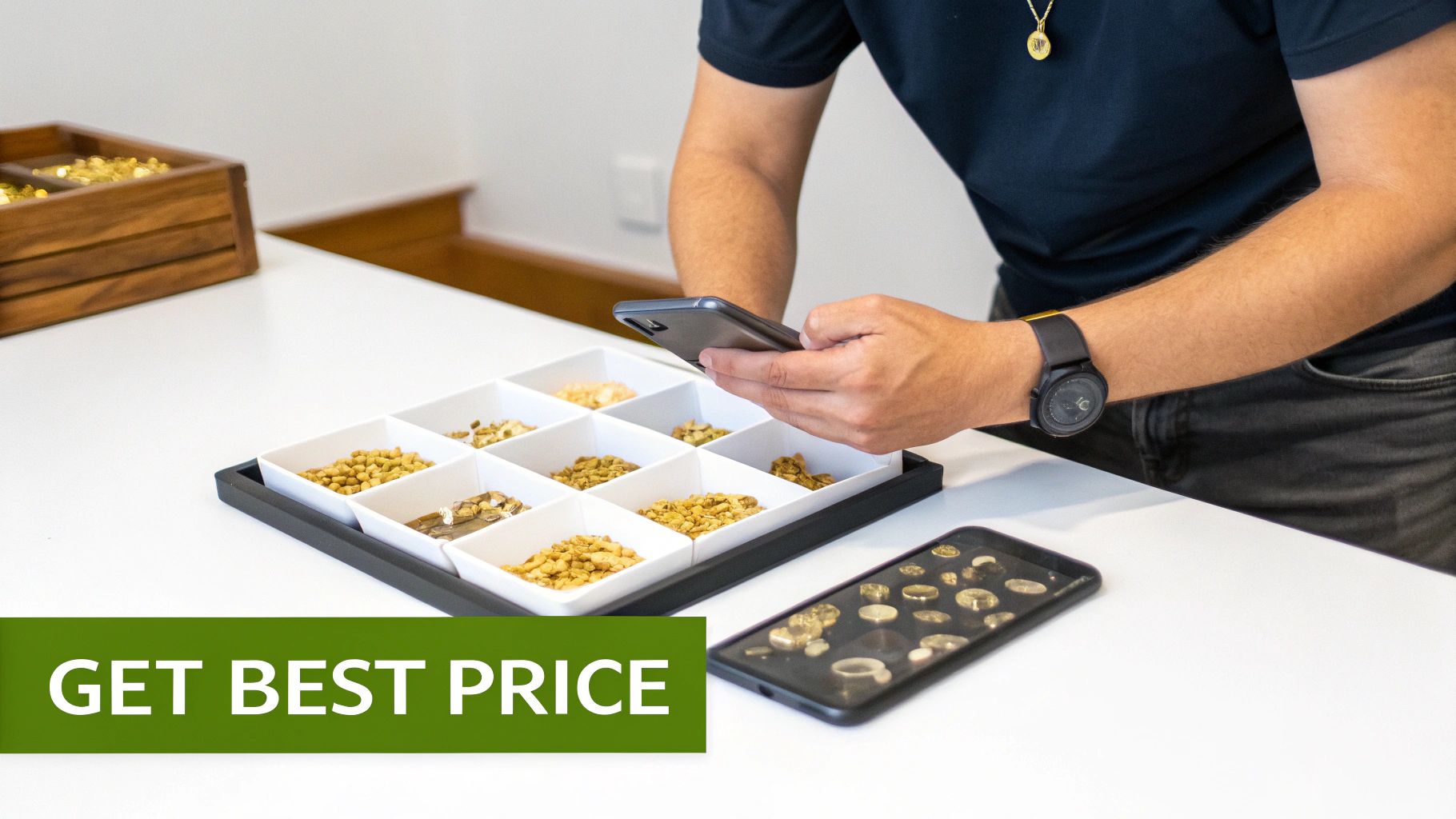
Now that you have a handle on what drives your gold’s value, it is time to put that knowledge to work. A few smart moves before you sell can make a real difference in the cash you walk away with. These are not complicated tricks, just practical steps to help you navigate the process like a pro and get a great price for your scrap gold.
Think of it like preparing for any important negotiation. The more organized and informed you are, the stronger your position will be.
Separate Your Gold by Karat
This is probably the single most effective thing you can do. Before you even think about visiting a buyer, sort your gold jewelry by its karat purity.
Tossing a mix of 10K, 14K, and 18K pieces into one big pile can work against you. Some buyers might be tempted to quote you a flat price based on the lowest purity item in the bunch, which seriously undervalues your better pieces. By separating everything beforehand, you are sending a clear signal that you know what you have and expect an itemized, transparent valuation.
Get Multiple Quotes from Reputable Buyers
You would not buy a car without shopping around, so do not sell your gold on the first offer. Payout percentages can swing wildly from one dealer to the next, so getting at least two or three different quotes is non negotiable. It gives you a clear picture of the market and some serious negotiating leverage.
Reputation is everything in this business. Before you go anywhere, do a little homework. Check online reviews, look up their Better Business Bureau rating, and see what past customers are saying. A trustworthy buyer will be transparent, explain their process, and test your gold right in front of you. Finding out where to sell gold for the highest price almost always comes down to doing this simple legwork first.
A reputable dealer expects you to be informed. They will respect your knowledge and are more likely to offer a competitive price when they see you have done your homework and are comparing options.
Understand the Buyer’s Process and Stay Aware
Knowledge is your best friend when it is time to sell. Knowing the live spot price of gold before you walk through the door gives you an instant benchmark for any offer. You can find this on financial news sites or, even easier, by using an online gold calculator.
This lets you quickly gauge whether an offer is in the right ballpark. To see just how much this matters, the table below shows how different payout percentages affect your final offer on a piece with a calculated melt value of $500.
| Melt Value | Payout Percentage | Your Potential Offer |
|---|---|---|
| $500 | 70% | $350 |
| $500 | 80% | $400 |
| $500 | 90% | $450 |
| $500 | 95% | $475 |
As you can see, a 10% difference in the payout means $50 more (or less) in your pocket for every $500 of your gold’s value. By showing up prepared, sorting your gold, and shopping around, you empower yourself to close a deal you can feel genuinely good about.
Common Questions About Selling Gold
Even after getting a handle on how scrap gold prices work, there are always a few questions that pop up. Let’s tackle some of the most common ones we hear, so you can walk into a sale feeling completely prepared and confident.
Does the Condition of My Jewelry Affect Its Scrap Price?
For scrap gold, the short and simple answer is no. Buyers are interested in one thing: the melt value of your gold. That value is based entirely on its weight and karat purity.
A broken chain, a single earring, or a deeply scratched ring is destined for the melting pot anyway, so its cosmetic condition does not matter for its raw material value.
That said, if you have a piece from a high end designer like Tiffany & Co., or it is a desirable antique, it could be worth more sold as a finished piece of jewelry. It is always a good idea to figure out if your item has value beyond its gold content before you decide to scrap it.
What Is the Difference Between a Troy Ounce and a Regular Ounce?
This is a really important one, and a classic source of confusion in the precious metals world. A troy ounce, which is the standard unit for gold, weighs 31.1 grams. A standard ounce (technically called an avoirdupois ounce), like the one you would use for cooking, is lighter at just 28.35 grams.
That is a difference of nearly 10%, which is huge when you are talking about value. Always make sure you know which “ounce” is being quoted. Any reputable dealer will work in troy ounces or, even more commonly, grams.
How Can I Tell if My Gold Is Real Before Selling?
While a professional test is the only way to be 100% certain, you can do a few simple checks at home to get a good idea.
First, look for a hallmark. This is a tiny stamp, usually on the clasp or inside a ring, that indicates the karat (like “14K,” “18K,” or the European equivalent “585” or “750”). Second, real gold is not magnetic. If a magnet snaps right onto your item, it is a dead giveaway that it is not solid gold.
Here is a quick reference table to help you out:
| Test | Real Gold | Likely Fake |
|---|---|---|
| Magnet Test | Not magnetic | Sticks to a magnet |
| Hallmark Stamp | Clearly stamped (“18K,” “750”) | No stamp, or unusual markings |
| Skin Discoloration | Does not tarnish or stain skin | Can leave green or black marks |
These quick checks can help you sort your items and set your expectations. From there, an accurate valuation from a professional will give you the final, definitive answer.
Ready to see what your gold is worth right now? The Gold Calculator provides instant, transparent valuations based on live market data. Our free tool empowers you to understand the true melt value of your items before you sell, ensuring you negotiate with confidence.


